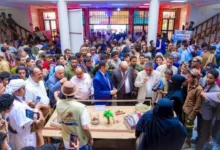A British Museum exhibition challenges misconceptions about ‘Islamic art’

SMA NEWS – LONDON
At first glance, the description of a new exhibition and accompanying book celebrating a decade of the British Museum collecting contemporary art of the Middle East and North Africa appears unnecessarily cumbersome, if not evasive.
The exhibition “Reflections: Contemporary art of the Middle East and North Africa,” writes Venetia Porter, the museum’s curator of Islamic and contemporary Middle East art, is “about a collection of works in the British Museum … made by artists born in or connected to countries that include Iran, Turkey, Lebanon, Saudi Arabia, Egypt and Tunisia, states that belong within the region known today as the Middle East and North Africa.”
In fact, far from being evasive, Porter is exercising precision, and mounting a challenge to what she sees as the frequently misused term “Islamic art,” and the perception in the West that there is only a single narrative at play in a region rich with a vast diversity of cultures, histories and current concerns.
“There’s a lot of misunderstanding about what this material from the modern and contemporary era is,” said Porter as the museum put the finishing touches to an exhibition that was due to open on Feb. 11 but which, thanks to COVID-19 restrictions, will now be launched only virtually.
“Some people will call it contemporary or modern Islamic art and I have issues about that. For a start the term ‘Islamic art’ is very complicated. It was created by western scholars and to a certain extent we are stuck with that now.”
But it is, she says, a “very reductive,” or simplistic term, and “the modern and contemporary art from this wide region is something that is so far removed from that description.”
Talking about Middle Eastern or North African art, she admits, “isn’t perfect either, although I feel it just gives it a bit more flexibility.”
But in the future, she says, “perhaps we shan’t have to use these terms at all.” One day, perhaps, “we will be able to talk just about ‘art’.”







